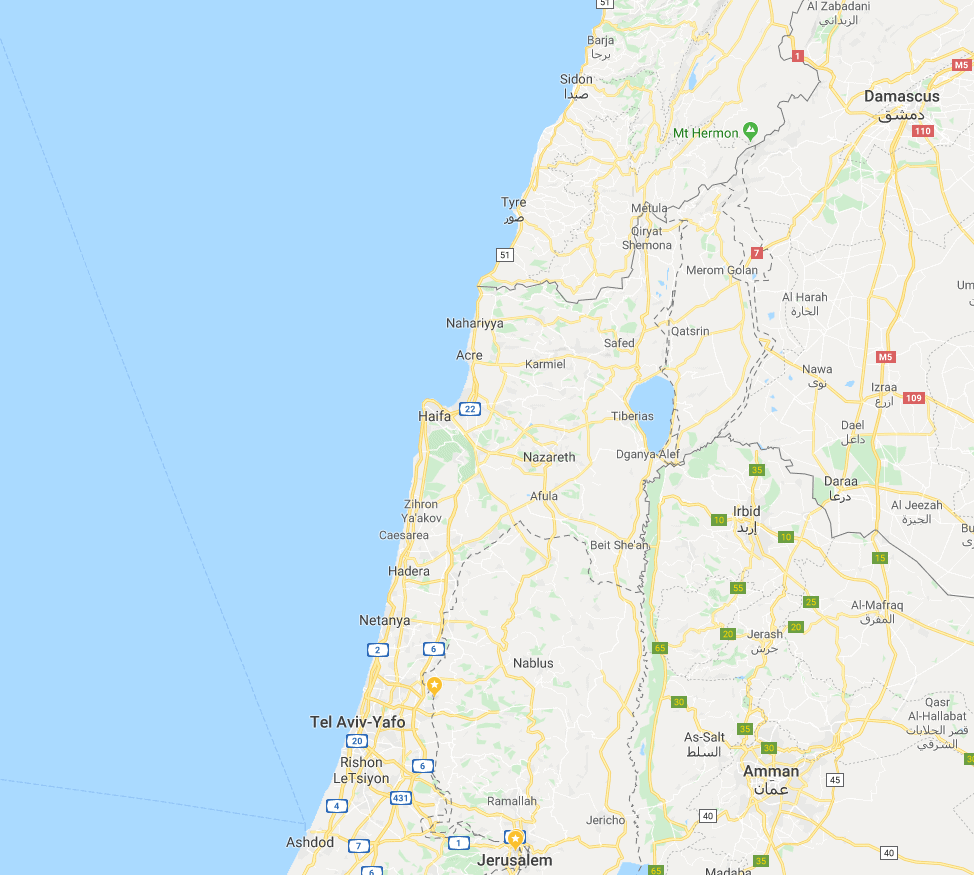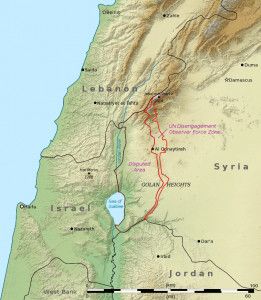Situated high up on Israel’s northern frontier with Syria and Lebanon, the Golan Heights’ importance to Israel cannot be understated. Learn more about the area, its history and people in this quick guide. Read on here for an in-depth look at the region’s area, history and people, and check out this article for some lesser-known Golan Heights facts.
From time to time, the issue of the Golan Heights surfaces and international attention focuses on whether the territory should remain under Israeli control or be returned to Syria. But where is the Golan Heights, and why is it it so significant? Who lives there, and whose land is it really?
First, the basics: Situated adjacent to the Kinneret Lake, also known as the Sea of Galilee, the Israeli side of the Golan Heights covers around 500 square miles of fertile highland offering a commanding view over Israel and Syria. Ever since, both countries have claimed it as their own.

Following taking control of the land in the 1967 Six-Day War, Israel has come under intermittent international pressure to return the land to Syria, a demand Israel rejects as inappropriate and impossible. But why?
Ancient Jewish History in the Golan
To understand the Israeli position, it’s important to understand both the contemporary security needs of the modern state of Israel, as well as the Jewish people’s deep ties with the territory. Jewish history in the Golan dates back to Biblical times, with the existence of Jewish life in the area recorded in various texts, including the books of Deuteronomy and Joshua. Back then, the region was known as the Bashan. The name Golan itself derives from the city of Bashan, which the Bible documents as one of 60-something fortified cities in the area. Golan functioned as a ‘city of refuge,’ a place where suspected murderers were allowed to flee to avoid reprisal.
Although the Jewish people were exiled from the Land of Israel on numerous occasions, Jewish exiles returned from Assyria, Babylonia and the region during numerous periods, even defying the great Roman army. The area is brimming with historic artifacts testifying to Jewish communal life in the land, and the repeated turnovers of control as the region was repeatedly taken, wrested back, and seized again. One particularly shocking episode at the clifftop town of Gamla closely resembled a famous final act of Jewish resistance at Masada when the besieged Jewish communities there committed mass suicide rather than surrender. When the Gamla fortifications were breached in 67 C.E., the entire Jewish community is said to have died; around half of them killed by the Romans, and the other half by jumping off the steep climbs to certain death.
Join the fight for Israel’s fair coverage in the news
Even after Jewish autonomy came to an end, Jewish life in the Golan continued. The remains of over 30 ancient synagogues have been discovered, ritual bathing facilities have been found, and beautiful mosaic floors with Jewish symbols have been found, all pointing to a sustained Jewish presence. Only in the 7th century were the Jewish communities of the Golan wiped out when Islamic invaders conquered the land from the Assyrians for the burgeoning Rashidun Caliphate. Only centuries later were Jews able to return to the land.
The Golan From Middle Ages to the Modern Era
Various peoples have resided in the Golan over the ages, with the Mongols, Persians, Romans and Arabs, some from as far away as Yemen, repeatedly invading. The Druze, a religio-political sect deriving from Islam, settled in the area in the 15th and 16th centuries and controlled the region for approximately 350 years, before the area was taken over by the Egyptians and then the Ottomans in quick succession.
The Golan’s population dwindled over the centuries as a result of the constant warring, leading to the region being almost entirely deserted by the mid-19th century, with one travel guidebook describing how only 11 of 127 ancient towns and villages in the area were populated.
Under Ottoman control, Jews attempted to return to the area, with a number of plots of land bought by Jews from Safed and Tiberias from Bedouins and by Baron Edmund de Rothschild. Farms and homesteads were established, although these didn’t last for long when the Ottomans seized the land. As the Ottoman Empire crumbled in 1917, territories were subsumed into the British and French empires, with Palestine falling under British control.
Related Reading: Five Golan Heights Facts You Didn’t Know
Three years later, Arab rioting forced the Jewish communities of the Golan to flee, and three years after that, in 1923, Britain and France came to an agreement in which the Golan was transferred to French territory in present-day Syria, in return for Mosul. The last remaining Jews were evicted by Syria in 1947 ahead of Israel’s independence, and took advantage of the location to fire armaments at Jewish communities and towns lying south of the ridge. The land remained largely free of Jews until 1967.
1948: The Establishment of Israel
During the Arab-Israeli war of 1948, the nascent Jewish state was attacked by local Palestinian Arab militias, together with Egyptian, Jordanian, Lebanese, Iraqi, and Syrian forces. Despite being surrounded and losing around 1% of its population at the time, Israel prevailed and its landmass expanded with the Jewish state ending up in control of one third more land than would have been allocated to it had a 1947 UN partition proposal not been rejected by the Arab leadership.
Following the war, Israel sought to establish borders with its Arab neighbors, but with the Arab states refusing to recognize Israeli legitimacy, an alternative was required. In the first half of 1949, armistice agreements were signed between Israel and Egypt, Lebanon and Jordan in quick succession. A further agreement was reached between Israel and Syria and signed on July 20 that year.
Armistice Demarcation Lines were established under the agreements. At Arab insistence, however, the agreements included a statement making clear that the lines would not constitute legally-binding borders. Article V of the Israeli-Syrian General Armistice Agreement (20 July 1949) begins:
It is emphasized that the following arrangements for the Armistice Demarcation Line between the Israeli and Syrian armed forces and for the Demilitarized Zone are not to be interpreted as having any relation whatsoever to ultimate territorial arrangements affecting the two Parties to this Agreement.
Unfortunately, despite signing this agreement, the drawing of an armistice line between Israel and Syria did not lead to genuine peace between the two. Over the following years, intermittent hostilities broke out, with both sides making incursions into the other’s territory, with Syria attacking Israeli farmers and Syrian Prime Minister Salah Bitar bombastically declaring in 1963 that the Arab states would wage “an unyielding campaign to prevent [Israel] from realizing its dream” of making the desert flourish with water from the Jordan River. Between 1950 and 1967, approximately 370 Israelis were hit by Syrian fire, with 121 killed. In 1955 alone, there were exchanges of fire on 52 days.
The first three months of 1967 saw over 270 border ‘incidents’ in Israel. The majority of these emanated from Syria, and caused rising concern in Israel. Things came to a head in April 1967 when Israeli tractors were targeted by Syrian machine gun and anti-aircraft fire, sparking a confrontation involving over 130 planes between the Israeli and Syrian air forces. With rising hostilities on multiple fronts, it was no surprise when the Six-Day War broke out the just under two months later.
1967: The Six-Day War and Its Aftermath
Years of provocation came to an end in early June 1967 when Israel seized the Golan Heights during the Six-Day War. After Egyptian President Gamal Abdel Nasser had his army close the Straits of Tiran in late May, a provocation considered an act of war, Israel held intense diplomatic meetings with Western leaders before realizing that it would have to act alone.
In the early hours of June 5, the Israeli Air Force launched a mass attack on Egyptian airfields. Despite being dealt a decisive blow, Egypt refused to admit defeat and Syria and Jordan consequently entered the war in the belief that Israel was on the back foot.
After a few chaotic attempts to attack Israel, the Syrian forces were repelled and forced to retreat.
On 7 and 8 June, the Israeli leadership debated about whether to attack the Golan Heights as well. Syria had supported pre-war raids that had helped raise tensions and had routinely shelled Israel from the Heights, so some Israeli leaders wanted to see Syria punished. Military opinion was that the attack would be extremely costly, since it would entail an uphill battle against a strongly fortified enemy. Despite the risks, Israel attacked on June 9 and swiftly gained control of the majority of the Golan Heights. The following day, Israel agreed upon a ceasefire with Syria, and a ceasefire line known as the Purple Line was established.
Join the fight for Israel’s fair coverage in the news
The war led to many thousands of Syrians fleeing from the Golan, with estimates suggesting somewhere between 80,000 and 131,000 were forced from or fled from their homes, and only approximately 7,000 remaining.
Within days of the war’s end, on June 19, 1967, the Israeli government proposed the return of the Sinai peninsula to Egypt along with the Golan Heights to Syria in return for a permanent peace settlement and a demilitarization of the returned territories. Israelis began moving into the Golan within months. By 1970, there were already 12 new communities.
1973: The Yom Kippur War
Syria tried to regain the Golan six years later, in 1973. The loss of the Golan Heights in 1967 profoundly affected Syria and prompted it to launch a surprise attack on Israel in co-ordination with Egypt on the holiest date of the Jewish calendar, Yom Kippur.
After initially losing great swathes of the territory, Israel eventually recovered and pushed the Syrians back. Thanks in great part to strong American support, the Israeli counterattack led to Israeli troops advancing to within 50km of Damascus. Israel withdrew, but signed a ceasefire agreement the following year which left almost the entirety of the Golan under Israeli control.
Under the agreement, a buffer zone amounting to about 5% of the disputed land was transferred to Syria and incorporated into a demilitarized zone governed by the United Nations Disengagement Observer Force (UNDOF) running adjacent to the ceasefire line in an area about 80km long and ranging between 0.5km to 10km wide. This area was designated as an Area of Separation (AOF) that neither Syrian nor Israeli troops are permitted to enter. About one thousand UNDOF troops are stationed in the region.
Despite not gaining any territory, many Syrians and Egyptians saw themselves as having won a moral victory over Israel after surprising their foe.
Related Reading: Five Golan Heights Facts You Didn’t Know
Another legacy of the war is the threat posed by landmines. On both the Syrian-controlled Golan as well as the Golan Heights, an unknown number of landmines, thought to be in the hundreds or thousands, have been left behind by the Syrian military. With numerous fields marked as no-go-zones due to landmines, the growth of some Israeli villages is restricted. Over 200 landmines have exploded on the Syrian Golan since the end of the war, and many more people have been injured and killed on the Israeli side too.
Annexation and Israeli Civil Rule over the Golan Heights
On 14 December 1981, Israel passed the Golan Heights Law that extended Israeli “laws, jurisdiction and administration” to the Golan Heights. Although the law effectively annexed the territory to Israel, it did not explicitly spell out a formal annexation.
In response, the United Nations Security Council resolution 497 demanded Israel rescind its decision, stating that “the Israeli decision to impose its laws, jurisdiction and administration in the occupied Syrian Golan Heights is null and void and without international legal effect.”
Israel, for its part, maintains that it may retain the area, as the text of Resolution 242 calls for “safe and recognized boundaries free from threats or acts of force.” However, the international community rejects Israeli claims to title to the territory and regards it as sovereign Syrian territory. Some, however, refer back to the fifth article of the Israeli-Syrian General Armistice Agreement (20 July 1949), which made clear that the old borders were never borders at all, but mere armistice agreements and thus the territory was never part of a sovereign Syrian state at all.
For decades, the Golan Heights Law was not recognized internationally by any other sovereign state. Nevertheless, in March 2019, almost 40 years since Israel’s Golan Heights Law was passed, the United States broke with the entire international community after President Trump announced that the US would recognize Israel’s sovereignty over the region.
Contemporary Residents of the Golan
Approximately 50,000 people now live in the Golan, with around 27,000 Jewish residents and 24,000 Arabs calling the region their home. The Jews live in 33 communities, the vast majority of which are kibbutzim and other communal villages, as well as the town of Katzrin. The Arabs living in the Golan include around 23,000 Druze who live in four villages close to the Syrian frontier.
Israel has invested substantial sums in installing and upgrading infrastructure and services for the benefit of the Arab and Jewish populations, in stark contrast to the 19-year period until 1967 when successive Syrian governments failed to invest in local infrastructure and services. Under Israeli rule, electric and water systems, as well as agricultural improvements, job training, and health clinics, were put in place.
The Druze are an Arabic-speaking esoteric ethno-religious group with close links to Islam, although they are not generally considered Muslims. As a religious minority dispersed throughout the Middle East, the Druze have frequently experienced persecution, except in Lebanon and Israel, where Druze judges, parliamentarians, diplomats, and doctors occupy the highest echelons of society.
Join the fight for Israel’s fair coverage in the news
Most of the Druze residents of the Golan Heights consider themselves to be Syrians. Around 90% continue to decline the option of taking Israeli citizenship, instead holding Israeli permanent resident status. Instead of an Israeli passport, many Druze hold an Israeli-issued laissez-passer document for traveling abroad, on which the citizenship field is left empty.
The decision of the majority of the Druze to refuse Israeli citizenship and consider themselves Syrians has multiple aspects. With the Golan Heights Druze previously Syrian subjects, their affiliation to Syria is undeniably genuine and many truly regard themselves as Syrian. For others, the reluctance to accept Israeli citizenship and continue calling themselves Syrian is a pragmatic decision borne of the understanding that if the Golan Heights were to ever again come under Syrian control, those Druze calling themselves Israeli would be regarded as traitors and potentially severely punished. With Israel willing to overlook the Druze unwillingness to publicly embrace Israeli sovereignty while Syria exhibits a less understanding attitude, the outcome for many is a foregone conclusion.
Despite the prevalence of non-citizenship, in recent years there has been talk of the Druze seeking greater political expression in Israel. Since 1981, the Golan’s four Druze villages have been served by representatives, but an understanding that the territory will not be returned to Syria in the foreseeable future, together with the aspirations of the younger generations to seek out greater economic opportunities has led some to advocate for greater cooperation within Israel’s political system. This paved the way for the first-ever Israeli municipal elections in the villages in October 2018, although turnout was markedly lower than the rest of the country.

The Syrian Civil War and the future of the Golan Heights
With the outbreak of the Syrian civil war in March 2011, as protests spun out of control and military elements defected to the opposition, Syrian leader Bashar al-Assad lost control of great swathes of the country. Over the following eight years, Assad fought to reassert dominance over the country, backed up by Iranian and Russian forces.
During this period, Israel supplied aid to hundreds of Syrians, established medical centers across the border, and delivered fuel, electric generators, water, food and clothing. While many of the recipients of the aid were ostensibly civilians, an unknown number were rebels fighting against the Syrian regime.
Related Reading: Five Golan Heights Facts You Didn’t Know
These acts occasionally provoked the Druze, who saw Syrian rebels as their enemies. The Druze accused rebels of committing atrocities against their community in Syria and called on Israel to stop treating injured fighters. On a number of occasions this antipathy spilled over into actual violence as enraged demonstrators attacked Israeli military ambulances, in one case killing a Syrian passenger and critically wounding another.
As a result of Assad’s loss of territorial integrity, areas inside and adjacent to the UNDOF force’s patrol zone came under rebel control. Due to their proximity to the fighting, UNDOF’s situation became increasingly precarious and in time the United Nations forces became a target for violence. Consequently, inspection patrols in the zone’s Area of Limitation ceased and, prompted by the kidnapping of some 45 Fijian UNDOF soldiers by an Al-Qaeda-affiliated group (the soldiers were subsequently released) and other attacks, the force abandoned most of its positions and withdrew to Israeli territory. For a period of five years, UNDOF forces observed events in Syria from the safety of Israeli-controlled land. As the civil war in Syria has drawn to an end, UNDOF soldiers have returned to the Syrian side of the line.
With intermittent hostilities crossing over the border, as the Israeli air force regularly attacks terror groups located on the Syrian side, and the Israeli side periodically coming under fire, the Golan Heights is set to remain under Israeli control for the foreseeable future.


